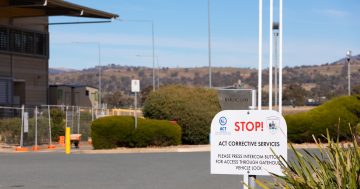
The intervention of ACT Corrective Services Commissioner Jon Peach was not beneficial to the management of the riot, the ACT Inspector of Correction Services found. Photo: Dominic Giannini.
ACT corrections staff were not adequately trained to handle the prison riot that broke out last November where $5.7 million of damage was caused after inmates began lighting fires, a review has found.
Less than 10 per cent of the staff on duty at the Alexander Maconochie Centre (AMC) told the review that they had effective training to deal with the riot.
Corrections Commissioner Jon Peach’s intervention and management of the issue was also found to have “outweighed the benefits”, according to the ACT Inspector of Correction Services, Neil McAllister.
The incident started as a passive protest about prisoners being unable to buy tobacco earlier that day but escalated when some of the 27 inmates involved in the standoff lit at least four fires and started destroying furniture and equipment.
Firefighters responding to the incident were pelted with metal and other hard objects when they tried to enter the cells. Prison staff were exposed to chemical-laden black smoke and had to continue working in wet uniforms from fire sprinklers for some hours.

Damage caused by the riot at the Alexander Maconochie Centre (AMC) in November 2020. Photo: Supplied.
The incident ended at 10:30 pm but most staff were not able to leave until about 3:30 am while cells were secured and prisoners were moved from damaged cells to new accommodation.
This meant some staff were on duty for about 20 hours.
More than 70 per cent of staff who spoke to the Inspector said they were not offered medical assistance after the incident while a further 10 per cent said they were unsure if they had been.
In his review of the incident, Mr McAllister said that Commissioner Peach acted in a manner “that was perceived by key staff as taking over command of the incident from the AMC General Manager”.
Mr Peach was suddenly moved on from his role of Commissioner at the start of March for the newly created role of executive group manager of security and emergency management within the Justice and Community Safety (JACS) Directorate.
Mr McAllistair made 13 recommendations, including an urgent update of the senior management structure to avoid confusion about responsibilities, a training officer be embedded in the AMC and a major training exercise be undertaken this year.
An audit of tactical gear and how quickly tactical gear can be accessed, as well as a decision on whether gas should be available as a use of force option, were also recommended.
Corrections Minister Mick Gentleman said that while corrections staff responded well, more work is needed to ensure staff can effectively perform their roles.
“The findings around a lack of staff support, training and access to equipment are particularly concerning to me,” Minister Gentleman said.
“I will task Acting Commissioner [Ray] Johnson with urgently reviewing the recommendations and developing an action plan for staff training and procedures when he commences next week.”
A second report by the ACT Auditor-General which was released on the same day found that ACT Corrective Services (ACTCS) also needed to review its procurement framework after fundamental failures in the purchase of a vehicle used to transport prisoners to court.
ACTCS did not prepare a business case, a plan or a risk assessment for the procurement and there was no evidence that the vehicle’s requirements were recognised in the process, the report found.
WorkSafe ACT issued the vehicle, known as Romeo 5, with a prohibition notice in November 2019, 18-months after its purchase, because it did not comply with weight requirements when loaded with detainees.
The maximum number of detainees it could carry has been reduced twice, down to three from the original eight.





















